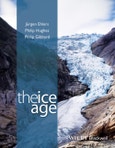This book provides a new look at the climatic history of the last 2.6 million years during the ice age, a time of extreme climatic fluctuations that have not yet ended. This period also coincides with important phases of human development from Neanderthals to modern humans, both of whom existed side by side during the last cold stage of the ice age. The ice age has seen dramatic expansions of glaciers and ice sheets, although this has been interspersed with relatively short warmer intervals like the one we live in today. The book focuses on the changing state of these glaciers and the effects of associated climate changes on a wide variety of environments (including mountains, rivers, deserts, oceans and seas) and also plants and animals. For example, at times the Sahara was green and colonized by humans, and Lake Chad covered 350,000 km2 – larger than the United Kingdom. What happened during the ice age can only be reconstructed from the traces that are left in the ground. The work of the geoscientist is similar to that of a detective who has to reconstruct the sequence of events from circumstantial evidence. The book draws on the specialisms and experience of the authors who are experts on the glacial history of the Earth.
Readership: Undergraduate and postgraduate students studying the Quaternary, researchers, and anyone interested in climate change, environmental change and geology. The book provides a rich collection of illustrations and photographs to help the readers at all levels visualise the dramatic consequences of glacier expansions during the Ice Age.
Table of Contents
About the Authors vii
Preface ix
Acknowledgements xi
About the companion website xiii
1. Introduction 3
1.1 In the Beginning was the Great Flood 4
1.2 The Ice Ages of the Earth 14
1.3 Causes of an Ice Age 18
2. The Course of the Ice Age 27
2.1 When did the Quaternary Period Begin? 27
2.2 What’s in Stratigraphy? 33
2.3 Traces in the Deep Sea 35
2.4 Systematics of the Ice Age 43
2.5 Günz, Mindel, Riss and Würm: Do They Still Apply? 46
2.6 Northern Germany and Adjacent Areas 58
2.7 The British Pleistocene Succession 76
2.8 Quaternary History of North America 86
2.9 The Course of the Ice Ages: A Global View 100
3. Ice and Water 107
3.1 The Origin of Glaciers 107
3.2 Recent Glaciers: Small and Large 113
3.3 Dynamics of Ice Sheets 121
3.4 Meltwater 129
4. Till and Moraines: The Traces of Glaciers 137
4.1 Till 137
4.2 Moraines 172
5. Meltwater: From Moulins to the Urstromtal 191
5.1 Fjords, Channels and Eskers 191
5.2 Outwash Plains and Gravel Terraces 202
5.3 Ice-dammed Lakes 207
5.4 Kames: Deposits at the Ice Margin 213
5.5 Urstromtäler 220
6. Maps: Where Are We? 227
6.1 Digital Maps 229
6.2 Satellite Images: Basic Data for Ice-Age Research 236
6.3 Projections and Ellipsoids 240
7. Extent of the Glaciers 243
7.1 Exploring the Arctic by Airship 243
7.2 Glaciers in the Barents Sea 244
7.3 Isostasy and Eustasy 246
7.4 Ice in Siberia? 252
7.5 Asia: The Mystery of Tibet 258
7.6 South America: Volcanoes and Glaciers 265
7.7 Mediterranean Glaciations 269
7.8 Were Africa, Australia and Oceania Glaciated? 272
7.9 Antarctica: Eternal Ice? 273
8. Ice in the Ground: The Periglacial Areas 277
8.1 Definition and Distribution 277
8.2 Extent of Frozen Ground during the Pleistocene 281
8.3 Frost Weathering 283
8.4 Cryoplanation 286
8.5 Rock Glaciers: Glaciers (Almost) Without Ice 288
8.6 Involutions 291
8.7 Solifluction 294
8.8 Periglacial Soil Stripes 296
8.9 Frost Cracks and Ice Wedges 297
8.10 Pingos, Palsas and other Frost Phenomena 301
9. Hippos in the Thames: The Warm Stages 311
9.1 Tar Pits of Evidence 311
9.2 Development of Fauna 312
9.3 Development of Vegetation 316
9.4 Weathering and Soil Formation 324
9.5 Water in the Desert: The Shifting of Climate Zones 336
9.6 Changes in the Rainforest 345
10. The Course of Deglaciation 349
10.1 Contribution to Landforms 349
10.2 Ice Decay 350
10.3 The Origin of Kettle Holes 354
10.4 Pressure Release 357
10.5 A Sudden Transition? 359
10.6 The Little Ice Age 363
11. Wind, Sand and Stones: Aeolian Processes 369
11.1 Dunes 369
11.2 Aeolian Sand 378
11.3 Loess 378
12. What Happened to the Rivers? 383
12.1 River Processes and Landforms 383
12.2 Dry Valleys 386
12.3 The Rhine: Influences of Alpine and Nordic Ice 387
12.4 The Elbe: Once Flowed to the Baltic Sea 396
12.5 The Thames: Influence of British Ice 400
13. North and Baltic Seas during the Ice Age 405
13.1 Development of the North Sea 406
13.2 Development of the Baltic Sea 414
14. Climate Models and Reconstructions 427
14.1 Ice Cores 427
14.2 The Marine Circulation 429
14.3 Modelling the Last Ice Sheets 431
14.4 Modelling Glaciers and Climate 442
15. Human Interference 447
15.1 Out of Africa: Humans Spread Out 448
15.2 Neanderthals and Homo sapiens 452
15.3 The Middle Stone Age 452
15.4 The Neolithic Period: The Beginning of Agriculture 453
15.5 Bronze and Iron 454
15.6 The Romans 455
15.7 Middle Ages 457
15.8 Recent Land Grab 457
15.9 Drying Lakes, Melting Glaciers and other Problems 459
15.10 The Anthropocene: Defining the Human Age? 465
References 469
Index 541








